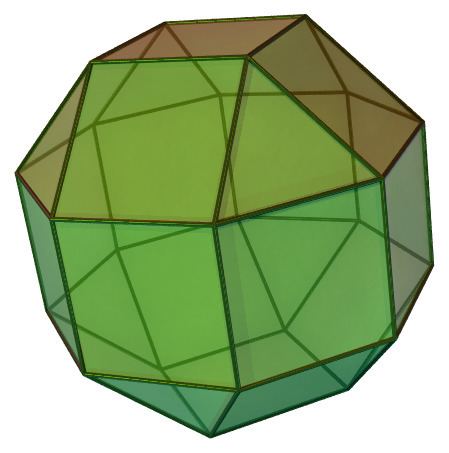Faces 8 triangles18 squares Vertices 24 Symmetry group D4d | Edges 48 Vertex configuration 8+16(3.4) | |
 | ||
Type JohnsonJ36 - J37 - J38 | ||
In geometry, the elongated square gyrobicupola or pseudorhombicuboctahedron is one of the Johnson solids (J37). It is not usually considered to be an Archimedean solid, even though its faces consist of regular polygons that meet in the same pattern at each of its vertices, because unlike the 13 Archimedean solids, it lacks a set of global symmetries that take every vertex to every other vertex (though Grünbaum has suggested it should be added to the traditional list of Archimedean solids as a 14th example).
Contents
- Construction and relation to the rhombicuboctahedron
- Symmetry and classification
- Related polyhedra and honeycombs
- In chemistry
- Additional reading
- References
This shape may have been discovered by Johannes Kepler in his enumeration of the Archimedean solids, but its first clear appearance in print appears to be the work of Duncan Sommerville in 1905. It was independently rediscovered by J. C. P. Miller by 1930 (by mistake while attempting to construct a model of the rhombicuboctahedron ) and again by V. G. Ashkinuse in 1957.
A Johnson solid is one of 92 strictly convex polyhedra that have regular faces but are not uniform (that is, they are not Platonic solids, Archimedean solids, prisms or antiprisms). They were named by Norman Johnson, who first listed these polyhedra in 1966.
Construction and relation to the rhombicuboctahedron
As the name suggests, it can be constructed by elongating a square gyrobicupola (J29) and inserting an octagonal prism between its two halves.
The solid can also be seen as the result of twisting one of the square cupolae (J4) on a rhombicuboctahedron (one of the Archimedean solids; a.k.a. the elongated square orthobicupola) by 45 degrees. It is therefore a gyrate rhombicuboctahedron. Its similarity to the rhombicuboctahedron gives it the alternative name pseudorhombicuboctahedron. It has occasionally been referred to as "the fourteenth Archimedean solid".
This property does not carry over to its pentagonal-faced counterpart, the gyrate rhombicosidodecahedron.
Symmetry and classification
The elongated square gyrobicupola possesses D4d symmetry. It is locally vertex-regular — the arrangement of the four faces incident on any vertex is the same for all vertices; this is unique among the Johnson solids. However, it is not vertex-transitive, and consequently not usually considered to be one of the Archimedean solids, as there are pairs of vertices such that there is no isometry of the solid which maps one into the other. Essentially, the two types of vertices can be distinguished by their "neighbors of neighbors." Another way to see that the polyhedron is not vertex-transitive is to note that there is exactly one belt of eight squares around its equator, which distinguishes vertices on the belt from vertices on either side. With faces colored by its D4d symmetry, it can look like this:
There are 8 (green) squares around its equator, 4 (red) triangles and 4 (yellow) squares above and below, and one (blue) square on each pole.
Related polyhedra and honeycombs
The elongated square gyrobicupola can form a space-filling honeycomb with the regular tetrahedron, cube, and cuboctahedron. It can also form another honeycomb with the tetrahedron, square pyramid and various combinations of cubes, elongated square pyramids, and elongated square bipyramids.
The pseudo great rhombicuboctahedron is a noncovex analog of the pseudo rhombicuboctahedron, constructed in a similar way from the nonconvex great rhombicuboctahedron.
In chemistry
The polyvanadate ion [V18O42]12− has a pseudorhombicuboctahedral structure, where each square face acts as the base of a VO5 pyramid.
